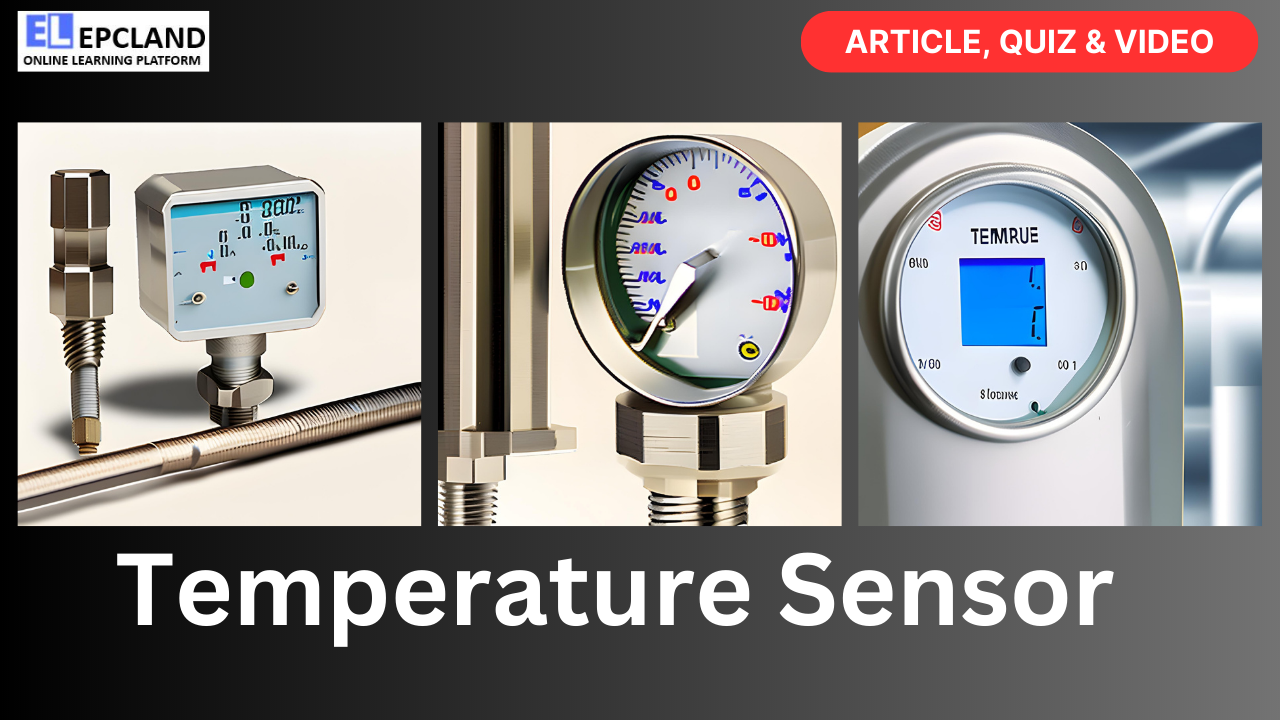Temperature sensing is a critical aspect of the Oil and Gas Industry. Accurate temperature measurements are essential for ensuring the safety, efficiency, and reliability of various processes and equipment within the industry. In this article, we will explore the importance of temperature sensors in the Oil and Gas sector, the types of temperature sensors commonly used, their applications, and the challenges faced in this demanding environment.
Table of Contents
Do not miss the detailed course 7 Modules of Piping Codes & Standards
Enrollment link
The Significance of Temperature Sensors in Oil and Gas Industry
Temperature is a fundamental parameter in the Oil and Gas Industry, influencing a wide range of operations and processes. The accurate measurement of temperature is crucial for several reasons:
1. Safety
Safety is paramount in the Oil and Gas Industry, where flammable materials and high-pressure systems are common. Monitoring temperatures helps prevent equipment failures and potential disasters due to overheating.
2. Process Control
Temperature control is vital for optimizing processes. Inaccurate temperature measurements can lead to inefficient operations, reduced product quality, and increased energy consumption.
3. Equipment Health
Excessive temperatures can damage equipment and reduce its lifespan. Regular monitoring with temperature sensors helps detect anomalies and schedule maintenance proactively.
4. Compliance
The industry is subject to strict regulatory standards. Accurate temperature monitoring ensures compliance with safety and environmental regulations.
Types of Temperature Sensors
Temperature sensors come in various types, each with its own advantages and limitations. The choice of sensor depends on the specific application and environmental conditions. Here are some commonly used temperature sensors in the Oil and Gas Industry:
1. Resistance Temperature Detectors (RTDs)
RTDs are one of the most accurate temperature sensors available. They operate on the principle that the electrical resistance of certain materials, such as platinum, changes with temperature. RTDs provide precise measurements, making them suitable for critical applications.
2. Thermocouples
Thermocouples are widely used in the industry due to their ruggedness and broad temperature range. They work based on the Seebeck effect, where the voltage generated at the junction of two different metals is proportional to the temperature difference. However, they are less accurate than RTDs.
3. Infrared (IR) Temperature Sensors
IR temperature sensors measure the infrared radiation emitted by an object to determine its temperature. They are non-contact sensors, making them suitable for remote or hazardous environments. IR sensors are commonly used for monitoring equipment and processes from a distance.
4. Thermistors
Thermistors are temperature-sensitive resistors that exhibit a significant change in resistance with temperature. They are cost-effective and used in applications where high accuracy is not essential.
5. Bimetallic Temperature Sensors
Bimetallic temperature sensors consist of two different metals bonded together. When exposed to temperature changes, the metals expand or contract at different rates, causing the sensor to bend. This bending is used to measure temperature variations.
Applications of Temperature Sensors in the Oil and Gas Industry
Temperature sensors find widespread use in various aspects of the Oil and Gas sector:
1. Well Monitoring
In drilling and well operations, temperature sensors are essential for monitoring downhole conditions. They help assess reservoir temperatures and detect any anomalies or overheating in the drilling process.
2. Refining and Processing
Temperature control is crucial in refining and processing facilities. Temperature sensors are employed in distillation columns, reactors, and heat exchangers to optimize the refining process and maintain product quality.
3. Pipeline Monitoring
Pipelines are a vital component of the Oil and Gas infrastructure. Temperature sensors along pipelines help detect leaks and ensure that transported fluids remain within safe temperature ranges.
4. Storage Tank Management
Temperature sensors in storage tanks ensure that the contents remain at the desired temperature. This is particularly important for materials that need to be stored or transported at specific temperature conditions, such as liquefied natural gas (LNG).
5. Safety Systems
Temperature sensors are integrated into safety systems to monitor and trigger alarms or emergency shutdowns when temperatures exceed predefined limits. This is critical for preventing accidents and protecting personnel.
6. Environmental Monitoring
Monitoring and controlling emissions from industrial processes is essential for compliance with environmental regulations. Temperature sensors play a role in ensuring that exhaust gases are properly treated.
Challenges in Temperature Sensing in the Oil and Gas Industry
While temperature sensors are essential in the industry, their application presents several challenges:
1. Extreme Conditions
The Oil and Gas Industry operates in extreme conditions, including high temperatures, high pressures, and corrosive environments. Temperature sensors must be designed to withstand these harsh conditions to provide reliable measurements.
2. Calibration and Accuracy
Maintaining the accuracy of temperature sensors is critical. Frequent calibration is necessary to ensure that measurements remain precise, especially in critical applications.
3. Remote Locations
Many oil and gas facilities are located in remote or offshore locations. Accessing and maintaining temperature sensors in these areas can be challenging and expensive.
4. Safety
Ensuring the safety of personnel and equipment is a top priority. Faulty temperature sensors can lead to dangerous situations, so redundant systems and regular maintenance are crucial.
5. Compatibility
Oil and gas facilities often use a mix of temperature sensors from different manufacturers. Ensuring compatibility and seamless integration of these sensors into the control system can be a complex task.
Innovations in Temperature Sensing
To address these challenges, the industry is constantly innovating in temperature sensing technology:
1. Advanced Materials
Developing materials that can withstand extreme conditions is a focus area. Sensor components are being made from materials that resist corrosion, erosion, and high temperatures.
2. Wireless Sensors
Wireless temperature sensors are becoming more prevalent, enabling remote monitoring and reducing the need for complex wiring in remote locations.
3. Smart Sensors
Smart temperature sensors are equipped with onboard processing capabilities. They can perform diagnostics, self-calibration, and transmit data in real-time, providing a wealth of information to operators.
4. Fiber Optic Temperature Sensors
Fiber optic sensors are immune to electromagnetic interference and can operate in explosive environments. They are increasingly used in downhole and other critical applications.
Conclusion
Temperature sensors are the unsung heroes of the Oil and Gas Industry, quietly ensuring that processes run safely and efficiently. From drilling and refining to pipeline transportation and storage, temperature measurements are critical for making informed decisions and preventing accidents.
In this article, we’ve explored the significance of temperature sensors in the industry, the types of sensors commonly used, their applications, and the challenges they face in this demanding environment. We’ve also highlighted some of the innovations shaping the future of temperature sensing in the Oil and Gas sector.
As the industry continues to evolve and face new challenges, temperature sensors will remain at the forefront of ensuring the safe and reliable operation of oil and gas facilities. Their continued development and integration into advanced control and monitoring systems will play a vital role in meeting the industry’s ever-growing demands.
Do not miss the detailed course 7 Modules of Piping Codes & Standards
Enrollment link
FAQs
- What are temperature sensors, and why are they essential in the Oil and Gas Industry?Temperature sensors are devices that measure temperature variations. In the Oil and Gas Industry, they are crucial for safety, process optimization, equipment health monitoring, and compliance with regulatory standards.
- What types of temperature sensors are commonly used in the industry?Commonly used temperature sensors include Resistance Temperature Detectors (RTDs), Thermocouples, Infrared (IR) temperature sensors, Thermistors, and Bimetallic temperature sensors.
- How do Resistance Temperature Detectors (RTDs) work, and where are they typically used?RTDs operate based on the change in electrical resistance with temperature. They are highly accurate and are often used in critical applications such as process control and safety systems.
- What are the advantages of Thermocouples in the Oil and Gas Industry, and where are they best suited?Thermocouples are known for their ruggedness and wide temperature range. They are suitable for applications where durability and a broad operating range are more important than extreme precision.
- What are Infrared (IR) temperature sensors, and how are they used in the industry?IR temperature sensors measure the infrared radiation emitted by objects to determine their temperature. They are often used for non-contact temperature monitoring in remote or hazardous environments.
- What role do temperature sensors play in drilling and well operations?Temperature sensors in drilling and well operations help monitor downhole conditions, assess reservoir temperatures, and detect anomalies to ensure the safety and efficiency of the drilling process.
- How are temperature sensors integrated into safety systems in the Oil and Gas Industry?Temperature sensors are integrated into safety systems to monitor temperatures and trigger alarms or emergency shutdowns when temperatures exceed predefined limits, helping to prevent accidents.
- What challenges do temperature sensors face in the Oil and Gas Industry?Challenges include extreme environmental conditions, the need for regular calibration, remote locations, safety considerations, and ensuring compatibility among sensors from different manufacturers.
- What are some recent innovations in temperature sensing technology for the Oil and Gas Industry?Recent innovations include the use of advanced materials for sensor components, wireless sensors for remote monitoring, smart sensors with onboard processing capabilities, and fiber optic temperature sensors for critical applications.
- How will the future of temperature sensing impact the Oil and Gas Industry?The future of temperature sensing in the industry will likely involve even more advanced and accurate sensors, increased integration with digital technologies like the Internet of Things (IoT), and a continued focus on safety and efficiency to meet evolving industry demands.
New Advanced courses (Published on EPCLand)
- Basics of Piping Engineering
- Piping Layout Engineering
- Piping Material Engineering
- Piping Stress Analysis
- Complete Course on Piping Engineering
- Material Requisitions
- Piping Material Specifications
- Valve Material Specifications
Don’t miss the published articles on following:
| Industrial Applications with Link | Industrial Applications with Link |
| Corrosion Monitoring Instruments | Safety Instrumented Systems |
| Instrumentation in Renewable Energy | Safety Relief Valves |
| Orifice Plate in the Oil & Gas Industry | Well Test Instruments |
| Wellhead Pressure and Temperature Gauges | Wireless Instrumentation in Oil & Gas Projects |
Do not miss the detailed course 7 Modules of Piping Codes & Standards
Enrollment link
Related Content on YouTube
Attempt Quiz
Question 1:
Which type of temperature sensor is commonly used in the oil & gas industry due to its ruggedness and wide temperature range?
Explanation: The correct answer is A) Thermocouple, which is known for its durability and wide temperature range.
Question 2:
What is the primary advantage of using Resistance Temperature Detectors (RTDs) in the oil & gas industry?
Explanation: The correct answer is B) High accuracy, which is a key advantage of RTDs.
Question 3:
Which temperature sensor type is commonly used in applications where a rapid response to temperature changes is crucial, such as in gas turbine monitoring?
Explanation: The correct answer is A) Thermocouple, known for its rapid response to temperature changes.
Question 4:
Which type of temperature sensor is ideal for non-contact temperature measurements in hazardous or inaccessible locations in the oil & gas industry?
Explanation: The correct answer is D) Infrared Sensor, which allows non-contact temperature measurements.
Question 5:
Which temperature sensor type exhibits a predictable change in electrical resistance with temperature, making it suitable for precision measurements in the oil & gas industry?
Explanation: The correct answer is B) Resistance Temperature Detector (RTD), known for its predictable change in resistance with temperature.



